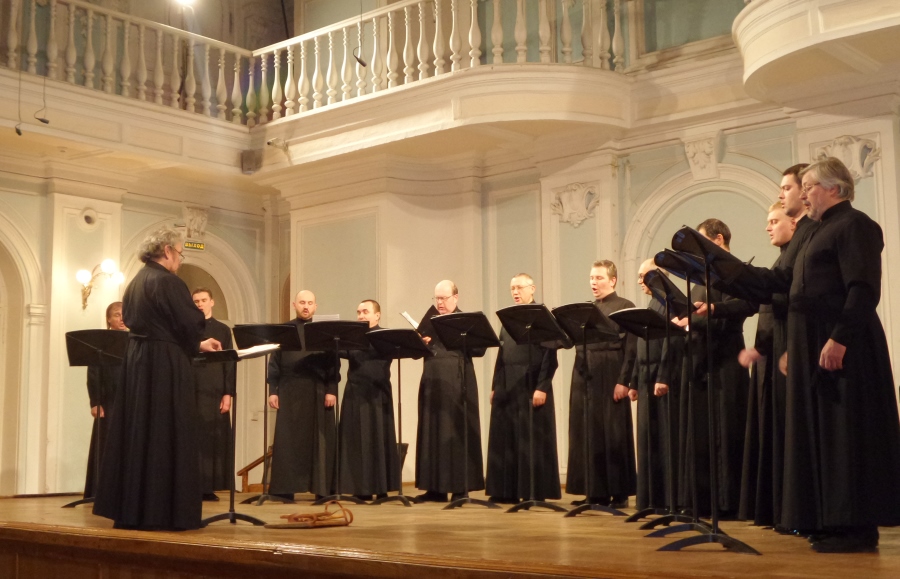The deep and resounding voices of the Moscow Patriarchate Choir leave listeners breathless and flabbergasted by the richly ornamental Orthodox Church music. The choir’s aim is to introduce the beauty of Russian sacred music to the world, after the decades-long period of suppression under the communist rule. The internationally successful choir is active in Moscow as a church ensemble, singing during religious services.
At Wratislavia Cantans the choristers will sing two settings of Psalm 1 ‘Blessed is the one who does not walk in step with the wicked’. A The Cherubic Hymn composed in a Polish monastery in Supraśl will follow, encouraging the faithful – compared to the highest Chorus of angels – to abandon earthly concerns and accept the King. Sticherons and troparions explain the meaning of festive days. The song The Joy of all the Sorrowful refers to a miraculous icon of Our Lady in one of Moscow’s churches. In the ardent ektenya (litany), the supplications of the deacon will be followed by the chorus singing Gospodi, pomiluj (Lord have mercy). The Great Prokeimenon by Dmitri Bortnansky is worth special attention, as the famous composer lived in the 17th c. when polyphony was allowed in the Orthodox Church and the kind of Orthodox Church music as we know it today began to be written. The choir will also sing secular songs, such as Tchaikovsky’s a cappella song setting a poem entitled The Angel of Death. An Oriental Song by M. Lermontov.
Instruments are not allowed in the Orthodox Church, and in the beginnings of Christianity the ban on instruments in churches was universal. In ancient times musical instruments were associated with pagan cults and were believed to distract the faithful during prayers. Whereas singing was the proper way to express meaning, to convey and explain the dogma. Therefore the Russian Orthodox Church music is over a millennium-old tradition of expanding the potential of the human voice. Concerts of Orthodox Church music have been programmed at Wratislavia Cantans many times. The ceremonial, solemn hymns announcing the joy of resurrection and spreading the hope deriving from faith are so well matched with the leading theme of this year’s Wratislavia Cantans which is festive celebration.

Anonymous(16th century) Priidite, poklonimsya (Come and let’s bow to Him)
Anonymous(16th century) S nami Bog (God is with us)
Anonymous(17th century) Blazhen Muzh (Blessed is the Man, Psalm 1)
Anonymous (16th century) Sticheron to the Icon of Mother of God, Creator of Tsar Ivan the Terrible
Anonymous (17th century) Sticheron for Good Friday (Bulgarian chant)
Easter Troparion (Old Russian polyphony, 17th century)
Anonymous (16th century) The Cherubic Hymn
Eucharistic Canon (Old Russian polyphony, 17th century)
Hymn to the Mother of God (Old Russian polyphony, 17th century)
***
Anonymous (Kiev, 17th century) Blazhen Muzh (Blessed is the Man, Psalm 1)
Anonymous (Venetian style, 17th century) Akathist to the Mother of God, Creator of Tsar Aleksey Mikhailovich
Anonymous (Venetian style, 17th century) Sticheron for Resurrection
Dmytri Bortniansky (1751–1825) Te Deum
Pavel Chesnokov (1877–1944) Soviet preciecznyi (Gabriel stood before thee)
Piotr Goncharov (19th century) Krestu Tvoyemu (Thy Cross We Honour)
Pavel Chesnokov (1877–1944) Presvyatey Bogoroditse pomolimsia (Let Us Pray to the Holy Mother of God)
Aleksander Gretchaninov (1864–1956) Sugubaya Ektenia (The Litany of Fervent Supplication)
Anatoly Grindenko – conductor
Choir of the Moscow Patriarchate 'Drevenrusski Raspev'
